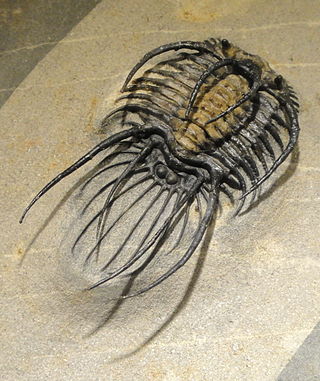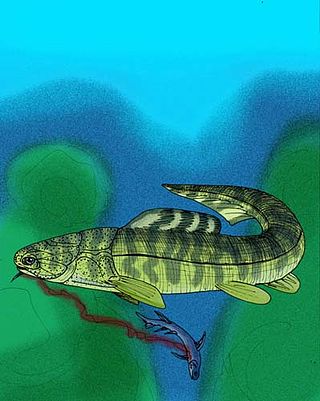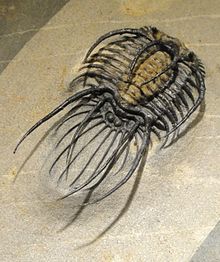
Protaspididae is an extinct family of pteraspidid heterostracan agnathans. Fossils of the various genera are found in early Devonian-aged marine strata. Protaspidids were once thought to represent a transitional form between the Pteraspididae and the Psammosteida, bearing the broad head shield shape of the latter, due to a more benthic (bottom-dwelling) existence, but recent phylogenical comparisons demonstrate that the protaspidids are actually highly derived pteraspidids, and that the anchipteraspidids, the most primitive of pteraspidids, are the sister-group of the psammosteids.

Acidaspis is an extinct genus of odontopleurid trilobite from the Ordovician to Silurian of North America and Europe. Although small, it had long spines along its body.
Dipentaspis is an extinct genus of damesellid odontopleurid trilobite. It lived during the Cambrian Period, which lasted from approximately 539 to 485 million years ago.
Adelogonus is an extinct genus of damesellid odontopleurid trilobite. It lived from 501 to 490 million years ago during the Dresbachian faunal stage of the late Cambrian Period.
Blackwelderioides is an extinct genus of damesellid odontopleurid trilobite. It lived from 501 to 490 million years ago during the Dresbachian faunal stage of the late Cambrian Period.
Histiomona is an extinct genus of damesellid odontopleurid trilobite. It lived from 501 to 490 million years ago during the Dresbachian faunal stage of the late Cambrian Period.

Selenopeltis is an extinct genus of odontopleurid trilobites in the family Odontopleuridae.

In geology, the Arenig is a time interval during the Ordovician period and also the suite of rocks which were deposited during this interval.

Ecphora is the common name for a group of extinct predatory marine gastropod mollusks within the family Muricidae, the rocks snails or murexes. The common name is based on the first officially described genus, Ecphora. The entire lineage of these ocenebrinid murexes are descended from the Eocene murex, Tritonopsis. Ecphoras were indigenous to the North American Eastern Seaboard, being found in marine strata from the Late Eocene until their extinction during the Pliocene. Many ecphora species are important index fossils.

Odontopleurida is an order of very spinose trilobites closely related to the trilobites of the order Lichida. Some experts group the Odontopleurid families, Odontopleuridae and Damesellidae, within Lichida. Odontopleurids tend to have convex, bar-shaped cephalons, and lobed, knob-shaped glabella that extend to, or almost to the anterior margin. Many, if not almost all odontopleurids have long spines that are derived either from the margins of the exoskeleton, or from granular or tubercular ornamentation, or both. Many odontopleurids are so spinose so as to be described as having "spines on (their) spines." Odontopleurids have 8 to 13 thoracic segments, with Odontopleuridae odontopleurids having no more than 10, and Damesellidae odontopleurids having no more than 13. The pygidium tends to be very small, and invariably has long spines emanating from it in all known genera.

Damesellidae is a family of odontopleurid trilobites found in late Middle to Late Cambrian marine strata, primarily of China. Damesellids are closely related to the odontopleurids of Odontopleuridae, but are not nearly as spinose, nor possess spines as exaggerated as Odontopleuridae. Like Odontopleuridae odontopleurids, damesellids have broad, bar-shaped cranidia with ledge-like borders. Damesellidae may represent transitional forms between more primitive, possibly ancestral ptychopariids and more advanced odontopleurids.
Cyrtoprora is an extinct genus of damesellid odontopleurid trilobite. It lived from 501 to 490 million years ago during the Dresbachian faunal stage of the late Cambrian Period.
Ceratocephala may refer to :

Buchanosteus is an extinct genus of arthrodire placoderm. Its fossils have been found in Early Devonian-aged marine strata throughout Asia and Australia. It contains the following species:

Proetus is a genus of proetid trilobite found in Silurian-aged marine strata of Europe.

Pteraspidiformes is an extinct order of heterostracan agnathan vertebrates known from extensive fossil remains primarily from Early Devonian strata of Europe and North America, and from Upper Silurian Canada.

Cyathaspidiformes is an extinct order of heterostracan vertebrates known from extensive fossil remains primarily from Silurian to Early Devonian strata of Europe, and North America, and from Early Devonian marine strata of Siberia.
Orphanaspis is a poorly known genus of odontopleurid trilobite in the family Odontopleuridae. The genus is originally based on poorly preserved material from the Wenlock-aged Motol Formation in Bohemia, Czech Republic, described by Joachim Barrande, in 1852, as "Trilobites orphana." In 1945, Prantl and Pribyl reclassify T. orphana as Orphanaspis orphana. Some experts suspect that O. orphana may actually be a species of Dicranurus.

Odontopleura is a genus of spinose odontopleurid trilobite in the family Odontopleuridae, and is the type genus of that family and of Odontopleurida. The various species are found in Upper Ordovician to Middle Devonian marine strata throughout the world. The best studied fossils are of the type species, O. ovata, from the Wenlock-aged Liteň Formation in Loděnice, in Bohemia, Czech Republic, and, southeastern Gotland, of Sweden.

The Kristianstad Basin is a Cretaceous-age structural basin and geological formation in northeastern Skåne, the southernmost province of Sweden. The basin extends from Hanöbukten, a bay in the Baltic Sea, in the east to the town of Hässleholm in the west and ends with the two horsts Linderödsåsen and Nävlingeåsen in the south. The basin's northern boundary is more diffuse and there are several outlying portions of Cretaceous-age sediments. During the Cretaceous, the region was a shallow subtropical to temperate inland sea and archipelago.


















